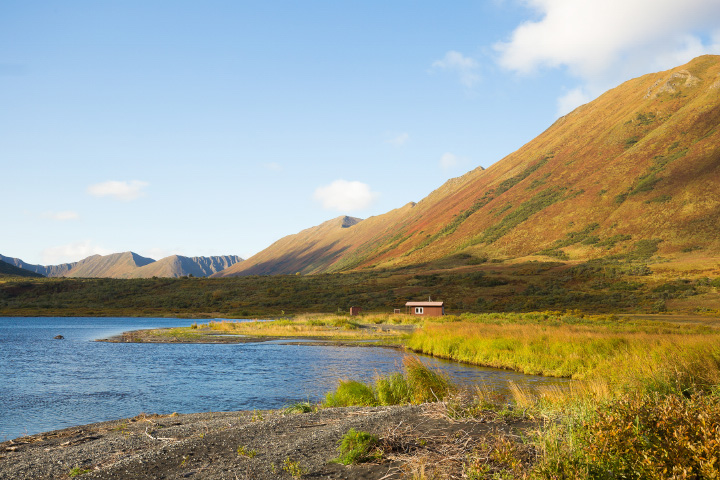
Warm Autumn Hues on Kodiak Island
Downloads
- kodiakwildliferefuge_oli2_2023276_lrg.jpg (2689x1793, JPEG)
- kodiakwildliferefuge_lrg.jpg (1800x1200, JPEG)
Metadata
- Sensor(s):
- Landsat 9 - OLI-2
- Data Date: October 3, 2023
- Visualization Date: October 10, 2023
As summer turns to fall in Alaska, days of abundant sunlight give way to rapidly encroaching darkness. Bears plump up for hibernation, while tundra plants harden themselves for the long, cold winter. Humans delight in all of this splendor, much of it from afar: watching brown bears nab salmon out of the river and grow into rotund beasts, and—if the clouds clear—catching a glimpse from space of autumn reds and golds.
The OLI-2 (Operational Land Imager-2) on Landsat 9 captured this image of fall colors blanketing Kodiak Island, the second-largest island in the United States and home of Kodiak National Wildlife Refuge, on October 3, 2023. The island’s terrain ranges from rugged coastline to spruce forest to snowy peaks. However, the southwestern part of Kodiak along the Shelikof Strait, shown here, is colder and drier than the maritime eastern side, and a tundra ecosystem predominates.
The vegetation on this part of Kodiak Island includes sedges, mosses, heaths, and grasses. Trees are generally absent, save for the occasional Sitka spruce. Moist peatlands fill in the bottoms of the valleys.
Fall colors on the tundra are on display in the photo (above), taken in September 2015 at the north end of Frazer Lake in Kodiak National Wildlife Refuge. In the short growing season of this harsh environment, plants spend as much time as possible on growth and reproduction while still allowing enough time to build up frost hardiness. Sunlight levels, snow conditions, and temperature are some of the factors thought to affect when tundra plants lose chlorophyll and reabsorb nutrients each year. However, those winter preparations in tundra ecosystems are not well understood.
Across the Shelikof Strait, bears preparing for hibernation in Katmai National Park (northwest of this image) spent time in the spotlight during the annual Fat Bear Week competition. (In 2023, Chunk and Grazer squared off in the finals.) Not to be outdone, an estimated 3,500 Kodiak brown bears (Ursus arctos middendorffi) roam the mountains, forests, and tundra on the islands of the Kodiak Archipelago. Kodiak brown bears can weigh twice as much as interior brown bears, better known as grizzlies. Females can reach 700 pounds (320 kilograms), and males can top out at 1,400 pounds (640 kilograms).
On Kodiak, the bears have access to a bounty of food sources, foraging among the salmonberry and elderberry patches and fishing in the streams. The Karluk River, for example, boasts one of the most famous sockeye salmon runs in Alaska, with the fish sometimes numbering in the millions. The river also supports a native stock of Chinook salmon and populations of several other salmon and trout species.
References
- Gehrmann, F., et al. (2022) Onset of autumn senescence in High Arctic plants shows similar patterns in natural and experimental snow depth gradients. Arctic Science, 8(3).
- Peteet, D.M., et al. (2019) Holocene Vegetation, Climate, and Carbon History on Western Kodiak Island, Alaska. Frontiers in Earth Science, Volume 7 – 2019.
- U.S. Fish and Wildlife Service Kodiak Brown Bear. Accessed October 10, 2023.
- U.S. Fish and Wildlife Service Kodiak National Wildlife Refuge. Accessed October 10, 2023.
NASA Earth Observatory image by Wanmei Liang, using Landsat data from the U.S. Geological Survey. Photo by Lisa Hupp, courtesy of the Alaska Region U.S. Fish & Wildlife Service. Story by Lindsey Doermann.
This image record originally appeared on the Earth Observatory. Click here to view the full, original record.
